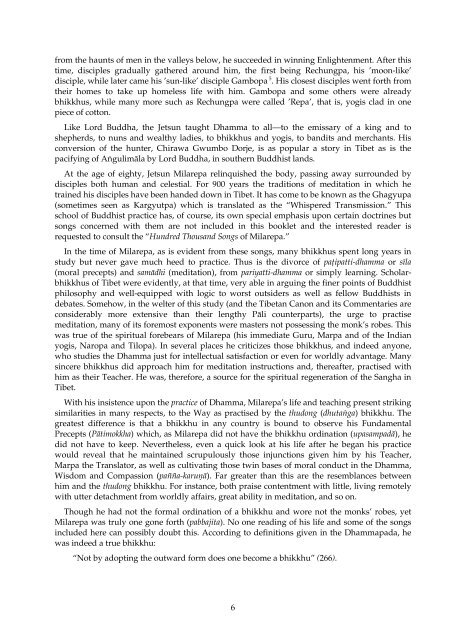Sixty Songs of Milarepa - Buddhist Publication Society
Sixty Songs of Milarepa - Buddhist Publication Society
Sixty Songs of Milarepa - Buddhist Publication Society
You also want an ePaper? Increase the reach of your titles
YUMPU automatically turns print PDFs into web optimized ePapers that Google loves.
from the haunts <strong>of</strong> men in the valleys below, he succeeded in winning Enlightenment. After this<br />
time, disciples gradually gathered around him, the first being Rechungpa, his ’moon-like’<br />
disciple, while later came his ’sun-like’ disciple Gambopa 5 . His closest disciples went forth from<br />
their homes to take up homeless life with him. Gambopa and some others were already<br />
bhikkhus, while many more such as Rechungpa were called ’Repa’, that is, yogis clad in one<br />
piece <strong>of</strong> cotton.<br />
Like Lord Buddha, the Jetsun taught Dhamma to all—to the emissary <strong>of</strong> a king and to<br />
shepherds, to nuns and wealthy ladies, to bhikkhus and yogis, to bandits and merchants. His<br />
conversion <strong>of</strong> the hunter, Chirawa Gwumbo Dorje, is as popular a story in Tibet as is the<br />
pacifying <strong>of</strong> Agulimāla by Lord Buddha, in southern <strong>Buddhist</strong> lands.<br />
At the age <strong>of</strong> eighty, Jetsun <strong>Milarepa</strong> relinquished the body, passing away surrounded by<br />
disciples both human and celestial. For 900 years the traditions <strong>of</strong> meditation in which he<br />
trained his disciples have been handed down in Tibet. It has come to be known as the Ghagyupa<br />
(sometimes seen as Kargyutpa) which is translated as the “Whispered Transmission.” This<br />
school <strong>of</strong> <strong>Buddhist</strong> practice has, <strong>of</strong> course, its own special emphasis upon certain doctrines but<br />
songs concerned with them are not included in this booklet and the interested reader is<br />
requested to consult the “Hundred Thousand <strong>Songs</strong> <strong>of</strong> <strong>Milarepa</strong>.”<br />
In the time <strong>of</strong> <strong>Milarepa</strong>, as is evident from these songs, many bhikkhus spent long years in<br />
study but never gave much heed to practice. Thus is the divorce <strong>of</strong> paipatti-dhamma or sīla<br />
(moral precepts) and samādhi (meditation), from pariyatti-dhamma or simply learning. Scholarbhikkhus<br />
<strong>of</strong> Tibet were evidently, at that time, very able in arguing the finer points <strong>of</strong> <strong>Buddhist</strong><br />
philosophy and well-equipped with logic to worst outsiders as well as fellow <strong>Buddhist</strong>s in<br />
debates. Somehow, in the welter <strong>of</strong> this study (and the Tibetan Canon and its Commentaries are<br />
considerably more extensive than their lengthy Pāli counterparts), the urge to practise<br />
meditation, many <strong>of</strong> its foremost exponents were masters not possessing the monk’s robes. This<br />
was true <strong>of</strong> the spiritual forebears <strong>of</strong> <strong>Milarepa</strong> (his immediate Guru, Marpa and <strong>of</strong> the Indian<br />
yogis, Naropa and Tilopa). In several places he criticizes those bhikkhus, and indeed anyone,<br />
who studies the Dhamma just for intellectual satisfaction or even for worldly advantage. Many<br />
sincere bhikkhus did approach him for meditation instructions and, thereafter, practised with<br />
him as their Teacher. He was, therefore, a source for the spiritual regeneration <strong>of</strong> the Sangha in<br />
Tibet.<br />
With his insistence upon the practice <strong>of</strong> Dhamma, <strong>Milarepa</strong>’s life and teaching present striking<br />
similarities in many respects, to the Way as practised by the thudong (dhutaga) bhikkhu. The<br />
greatest difference is that a bhikkhu in any country is bound to observe his Fundamental<br />
Precepts (Pātimokkha) which, as <strong>Milarepa</strong> did not have the bhikkhu ordination (upasampadā), he<br />
did not have to keep. Nevertheless, even a quick look at his life after he began his practice<br />
would reveal that he maintained scrupulously those injunctions given him by his Teacher,<br />
Marpa the Translator, as well as cultivating those twin bases <strong>of</strong> moral conduct in the Dhamma,<br />
Wisdom and Compassion (pañña-karuā). Far greater than this are the resemblances between<br />
him and the thudong bhikkhu. For instance, both praise contentment with little, living remotely<br />
with utter detachment from worldly affairs, great ability in meditation, and so on.<br />
Though he had not the formal ordination <strong>of</strong> a bhikkhu and wore not the monks’ robes, yet<br />
<strong>Milarepa</strong> was truly one gone forth (pabbajita). No one reading <strong>of</strong> his life and some <strong>of</strong> the songs<br />
included here can possibly doubt this. According to definitions given in the Dhammapada, he<br />
was indeed a true bhikkhu:<br />
“Not by adopting the outward form does one become a bhikkhu” (266).<br />
6
















